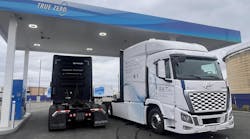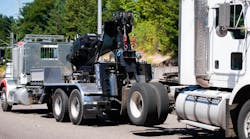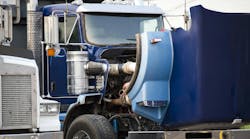Carriers in record numbers have decided they want to quit unnecessary engine idling and they want to do it now, before the cost of diesel goes even higher, before they are cited and fined for idling, or before their drivers migrate to fleets that already offer the comfort idle reduction systems can provide. Deciding to do something about idling is the easy part of the process, however. Deciding exactly what to do can be another matter entirely.
Brad Pinchuk, president and COO of Nebraska-based Hirschbach Motor Lines, a truckload refrigerated carrier, has experienced this dilemma first-hand. He recently completed an idle reduction (IR) system review and evaluation process and began installing the integrated auxiliary power units (APUs) the company selected.
“High fuel prices were what really motivated us to find an idle reduction solution,” Pinchuk says. “There were some surprises as we worked through the decision process, though. One of the biggest surprises was discovering just how much fuel our own trucks actually burned at idle. In the past, I'd said ‘no’ to purchasing idle reduction systems based upon the average fuel consumption at idle data we got from our engine suppliers. When we did the idle consumption tests for ourselves, however, it was a different story. We used the TMC procedure to test our trucks and they were all in excess of the average figures. We were burning .93 to 1.15 gallons per hour at idle.
“Doing our own fuel consumption testing was one of the breakthroughs in our analysis,” he recalls. “I think it is an absolutely essential step for any fleet considering implementing an idle reduction system.” Pinchuk also recommends defining exactly what you want an idle reduction system to provide. Just heating? Heating and cooling? Additional power for hotel loads? “Based on where we run, I knew we needed both heating and cooling,” he notes.
“We currently have 425 trucks in all. Late last year, we began installing TriPac units from Thermo King Corporation on all our trucks two years old or younger,” Pinchuk says. “We've installed about 65 systems so far. We'll also put the TriPacs on all new trucks we purchase. I expect it will take a couple of years to equip our entire fleet.
“It is one thing to install a system and another to get your drivers to use it as intended,” he continues. “We had experimented before with a heating-only system and it worked very well, but the drivers used the auxiliary system while they idled the truck to run its heater, too. This time we wanted a system that could be installed to require an engine-off mode to operate. I recommend that no matter what kind of system you choose. Now we give our drivers three minutes of idle time and then the engine shuts down and the TriPac system comes on automatically based on the thermostat setting for the cab and sleeper.
“We have an onboard computer attached to our engines so we have visibility to the engines' performance right from our office,” he adds. “It is very easy to see what is really going on out there when it comes to idling. One of our drivers went from idling fourteen hours per day to fifteen minutes per day.”
Talking with other fleets about their experiences can also be very helpful, Pinchuk offers. “We talked to others using idle reduction systems,” he says. “Wal-Mart, for example, was very generous about sharing information. I even talked with some of their drivers and mechanics. In particular, be sure to ask about installation time so that you get a realistic picture of how it will impact your operation and can plan accordingly.” Pinchuk also recommends checking out the reputations of the suppliers you are considering, including making sure they have a parts and service support network that will meet your needs.
Linda Gaines, systems analyst at the Center for Transportation Research, Energy Systems Division of Argonne National Laboratory, has been working on an idling calculator to help fleets determine the payback period for systems they are considering, and she has a few tips of her own concerning the idle reduction decision process.
“Do your own cost of idling analysis,” she stresses, seconding Pinchuk's advice, and be sure to include idling during the workday, not just overnight. That can really add up. Don't dismiss shore power as an option either,” Gaines adds. “If your drivers park at one of your own terminals every night, installing AC power hook-ups may be a cost-effective, clean and quiet solution.” (Gaines is gathering data about the cost of idling for Argonne and invites any fleets willing to share information about their cost of idling to contact her at: [email protected])
DECISION SUPPORT
There is more information available than ever before from public and private sources to help guide fleets through the idle reduction selection process, including from system suppliers, so don't be afraid to ask them for assistance. As the idle reduction market has grown and matured, many suppliers have developed tools to help carriers define their needs and identify the types of solutions that are most appropriate.
“We have some calculator tools to help fleets project their potential fuel and cost savings,” notes Martin Duffy, vp engineering for Thermo King. “We really like to have potential customers test products for themselves, however, so if we feel like we have a good candidate, we often also run some demos for them,” he says.
“Schneider National, for example recently announced that the company is changing its Owner Operator Success Lease program to include our TriPac heating and cooling system in all new aerodynamic Freightliner Century, Kenworth T2000, Volvo 780 and Peterbilt 386 and 387 tractors, as well as on Schneider Finance's low-mileage, used tractors,” Duffy continues. “Before selecting TriPac, Schneider did a rigorous demo and comparison program for four to six months.”
Duffy also cautions prospective buyers to make sure they are always talking about delivered capacity to the cab when comparing BTUs (British Thermal Units). “You can't compare BTU output based on any single component of an idle reduction system,” he says. “You have to look at an entire system and what it actually delivers.”
For more information, go to Directory of idle reduction solutions.


